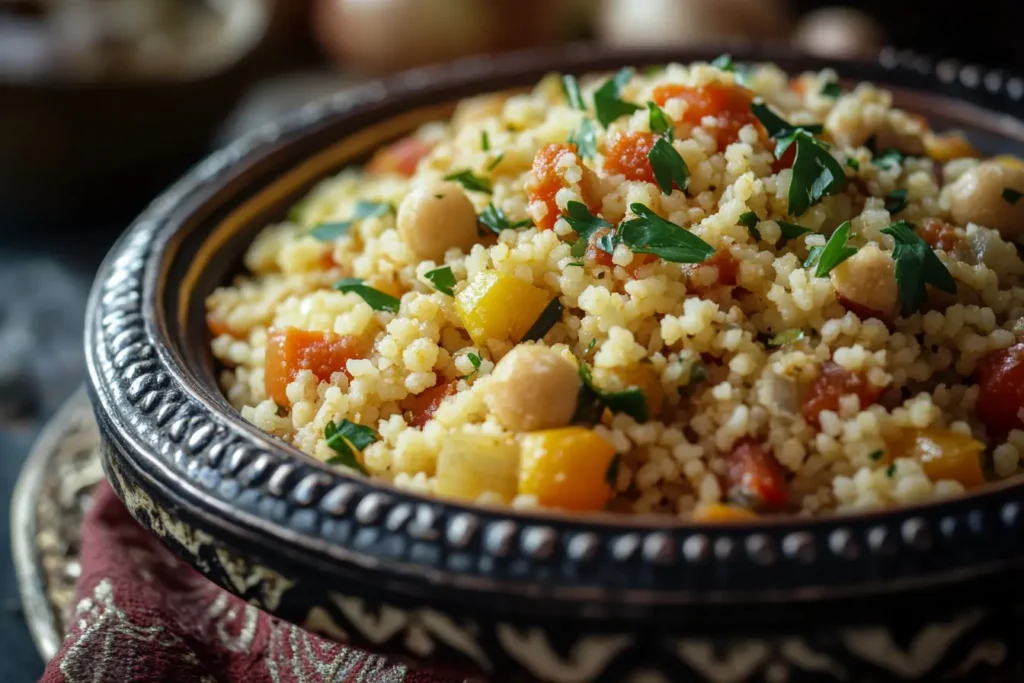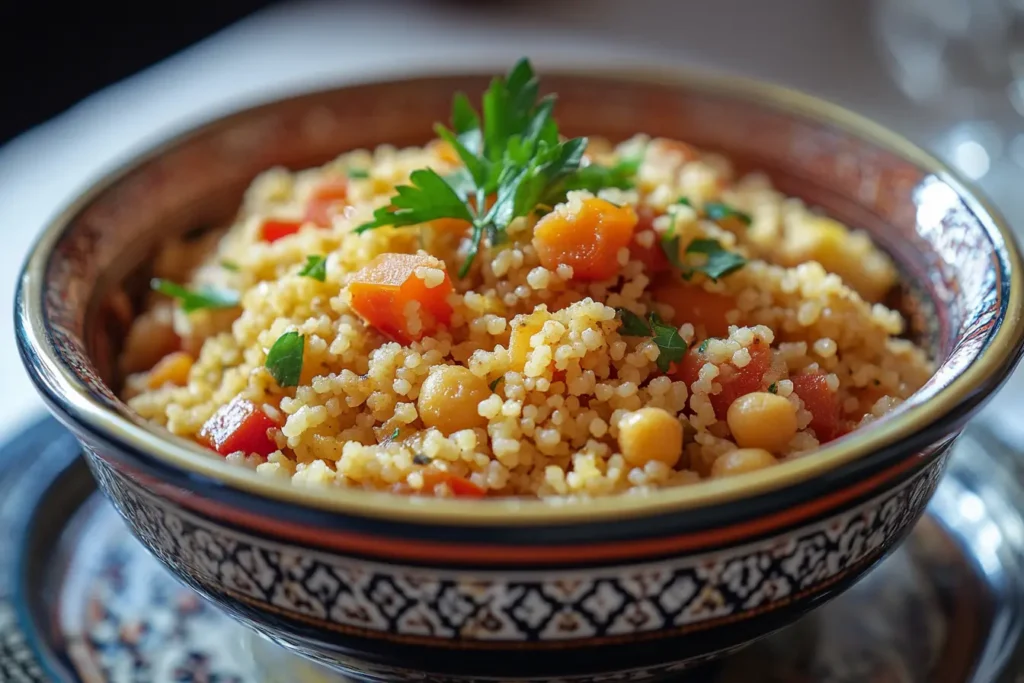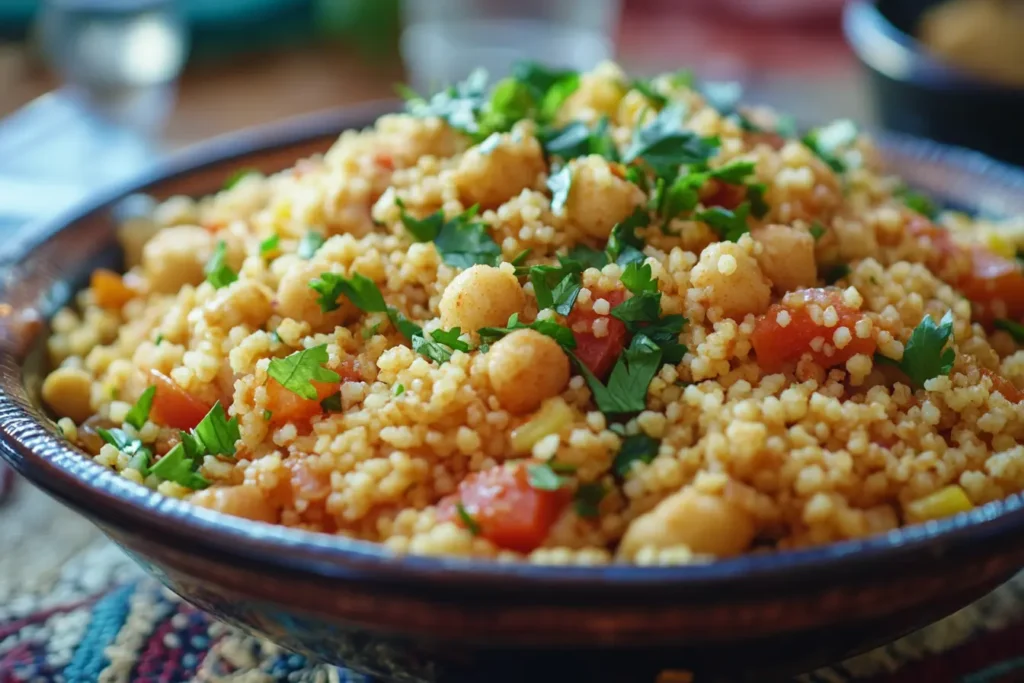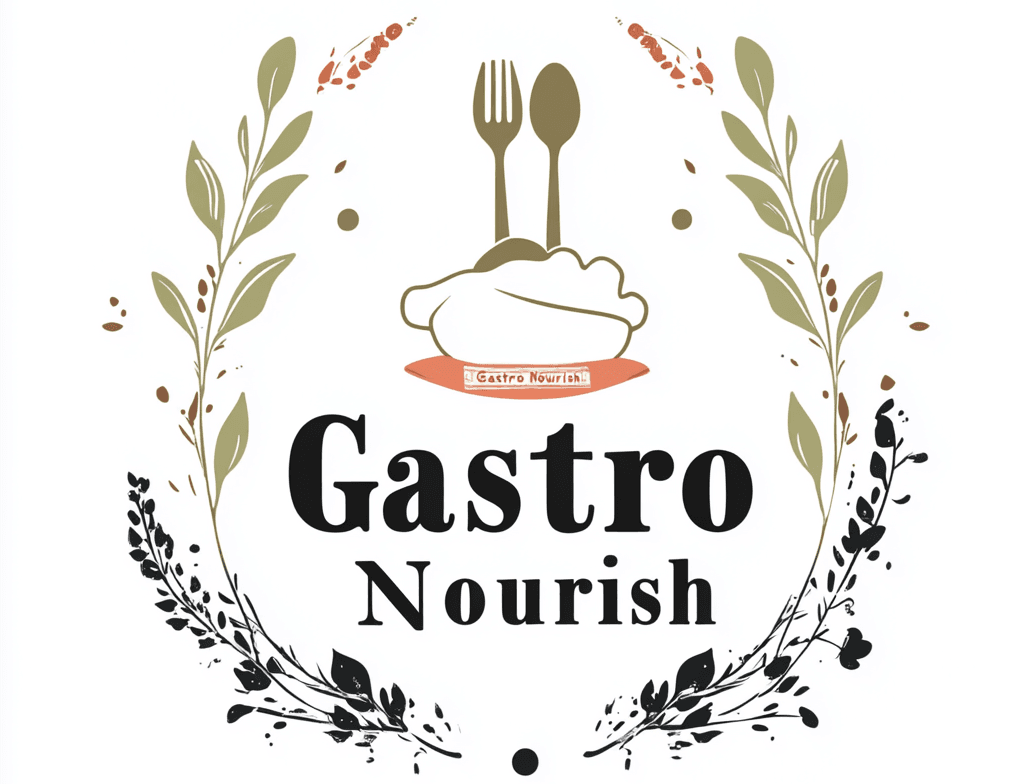Is Couscous a Pasta or Grain?
Couscous is a culinary delight that has puzzled many food enthusiasts. But what exactly is it? Is Couscous a Pasta or Grain? This question has sparked debates in kitchens and dining rooms around the world. In this article, we’ll dive into the origins, characteristics, and culinary uses of couscous to unravel this mystery. We’ll explore its nutritional profile, compare it to other foods, and even share some personal experiences. So, let’s embark on this flavorful journey to discover what couscous truly is.
Introduction

Couscous, a staple in North African cuisine, has made its way into kitchens worldwide. But what exactly is it? Is it a type of pasta, or does it belong to the grain family? This question isn’t just a matter of semantics; it influences how we cook, serve, and enjoy this versatile food. Understanding the classification of couscous can enhance your culinary repertoire and help you make informed dietary choices.
The debate over whether couscous is a pasta or a grain stems from its unique characteristics. Made from semolina, a type of wheat, couscous is often compared to pasta due to its similar preparation process. However, its small, granular form and nutritional profile also align it with grains. This dual identity makes couscous a fascinating subject for food lovers and nutritionists alike.
In this article, we’ll delve into the history and origins of couscous, examine its characteristics, and explore the arguments for and against its classification as pasta or grain. We’ll also look at its nutritional benefits, culinary uses, and answer some frequently asked questions. By the end, you’ll have a comprehensive understanding of couscous and its place in the culinary world.
What is Couscous?

Definition and Origin
Couscous is a tiny, steamed ball of crushed durum wheat semolina, and it’s a staple in North African cuisine. Originating from the Maghreb region, which includes countries like Morocco, Algeria, and Tunisia, couscous has been a dietary mainstay for centuries. But is couscous a pasta or grain? Traditionally, it was made by hand, with semolina sprinkled with water and rolled into small granules. These granules were then steamed over a simmering stew, allowing them to absorb the rich flavors of the dish.
The history of couscous is as rich as its taste. It dates back to the Berber people, who are indigenous to North Africa. They developed this ingenious method of cooking to make the most of their wheat harvests. Over time, couscous spread across the Mediterranean and into Europe, becoming a beloved dish in many cultures. Today, it’s enjoyed worldwide, from the bustling markets of Marrakech to the cozy kitchens of Paris.
People often associate couscous with communal meals and celebrations. In many cultures, they serve it in a large, shared dish, symbolizing unity and hospitality. This cultural significance adds another layer to its appeal, making it more than just a food—it’s a tradition.
Understanding the origins of couscous helps us appreciate its role in various cuisines and its journey from a regional specialty to a global favorite. Whether you’re enjoying a traditional Moroccan tagine or a modern couscous salad, you’re partaking in a culinary legacy that spans centuries.
Is Couscous a Pasta?
Characteristics of Pasta
To determine whether couscous is a pasta, we first need to understand what defines pasta. Typically, chefs make pasta from unleavened dough by mixing wheat flour with water or eggs, then forming it into various shapes and cooking it by boiling or baking. Semolina and water serve as the key ingredients, which also play a role in making couscous. This similarity in ingredients often leads people to assume that couscous is a type of pasta.
However, pasta usually takes on larger forms like spaghetti, penne, or lasagna sheets, while couscous remains much smaller and granular. The preparation process also differs; chefs knead and shape pasta, whereas they roll couscous into tiny granules and steam it. Despite these differences, the shared use of semolina strongly supports classifying couscous as a pasta.
Arguments for Couscous as Pasta
The argument for couscous being a type of pasta hinges on its production method and culinary uses. Like pasta, couscous is made from semolina, which is a byproduct of durum wheat. This connection to wheat-based products places couscous in the pasta family for many culinary experts.
Moreover, many chefs often use couscous in dishes similar to those featuring pasta. You can serve it with sauces, vegetables, and proteins, much like a traditional pasta dish. Its versatility in absorbing flavors and complementing a wide range of ingredients further blurs the line between pasta and grain.
In the culinary world, people sometimes refer to couscous as “Moroccan pasta,” highlighting its pasta-like qualities. Yet, its unique texture and preparation method set it apart, making it a distinct entity in its own right. For those interested in exploring the nutritional benefits of couscous, you might find this Healthline article on couscous nutrition insightful.

Is Couscous a Grain?
Characteristics of Grains
Grains are small, hard seeds harvested for food, and they form the basis of many diets worldwide. Common grains include wheat, rice, oats, and barley. They are typically rich in carbohydrates, fiber, and essential nutrients. Grains can be whole or refined, with whole grains retaining the bran, germ, and endosperm, offering more nutritional benefits.
Couscous, although made from wheat, often falls into the grain category because of its small, granular form. Unlike pasta, which chefs shape and cook, couscous resembles grains more closely in both appearance and texture. This resemblance leads many to classify couscous as a grain, especially when considering its nutritional profile.
Arguments for Couscous as a Grain
The argument for couscous being a grain is supported by its nutritional similarities to other grains. Couscous, particularly the whole wheat variety, is a good source of fiber and provides essential nutrients like selenium and magnesium. These attributes align it more closely with grains than with pasta.
Moreover, couscous is often used in dishes that traditionally feature grains. It can be served as a side dish, mixed into salads, or used as a base for stews and tagines. Its ability to absorb flavors and provide a satisfying texture makes it a versatile ingredient in grain-based recipes.
In many cultures, couscous is considered a staple grain, much like rice or quinoa. Its role in traditional dishes and its nutritional benefits reinforce its classification as a grain.
Nutritional Comparison
Couscous vs. Pasta
When comparing couscous to pasta, it’s essential to look at their nutritional profiles. Couscous, particularly the whole wheat variety, is lower in calories and carbohydrates than most traditional pasta. A typical serving of couscous contains about 176 calories and 36 grams of carbohydrates, making it a lighter option for those watching their caloric intake.
In terms of macronutrients, couscous provides a modest amount of protein, similar to pasta. However, it lacks the fiber content found in whole grain pasta, unless you opt for whole wheat couscous. This makes couscous a suitable choice for those seeking a lighter, less filling alternative to pasta.
Couscous vs. Grains
When compared to other grains, couscous holds its own in terms of nutritional value. While it may not be as fiber-rich as quinoa or brown rice, couscous offers a good balance of carbohydrates and protein. It’s also a source of essential minerals like selenium, which plays a role in immune function and thyroid health.
Couscous is often enriched with vitamins and minerals, enhancing its nutritional profile. This makes it a convenient and nutritious option for those looking to incorporate more grains into their diet. Its quick cooking time and versatility in recipes make it a popular choice for busy individuals seeking a healthy meal option.
In summary, couscous provides a unique blend of nutrients that align it with both pasta and grains. Its nutritional benefits, combined with its culinary versatility, make it a valuable addition to any diet. For more insights into how couscous fits into a Mediterranean diet, you might find this Mediterranean Living article on couscous informative.

Culinary Uses and Recipes
Popular Couscous Dishes
Couscous is a culinary chameleon, adapting to a variety of dishes and flavors. In North African cuisine, it’s often the star of the show, served with a hearty stew of vegetables and meat. But is couscous a pasta or grain? Traditional Moroccan couscous, for instance, is a feast for the senses, combining aromatic spices like cumin, coriander, and saffron with tender lamb or chicken and a medley of vegetables.
Beyond its traditional roots, couscous has found a place in modern kitchens around the world. It’s a popular choice for salads, where its light, fluffy texture pairs beautifully with fresh herbs, citrus, and a drizzle of olive oil. Couscous can also be used as a stuffing for vegetables like bell peppers or tomatoes, offering a delightful contrast of textures and flavors.
Cooking Techniques
Cooking couscous is a breeze, making it a favorite for quick and easy meals. The most common method involves steaming, which allows the granules to absorb moisture and become tender. To prepare couscous, simply bring water or broth to a boil, remove it from the heat, and stir in the couscous. Cover the pot and let it sit for about five minutes, then fluff it with a fork to separate the grains.
For those looking to enhance the flavor of couscous, consider toasting it lightly in olive oil before adding the liquid. This step adds a nutty depth to the dish, elevating its taste. Additionally, incorporating spices, herbs, or even a splash of lemon juice can transform a simple bowl of couscous into a culinary masterpiece.
Couscous’s versatility and ease of preparation make it an ideal ingredient for both novice cooks and seasoned chefs. Whether you’re crafting a traditional dish or experimenting with new flavors, couscous offers endless possibilities for delicious meals.
Personal Experience
My Experience with Couscous
Couscous has always held a special place in my kitchen. I remember the first time I tried it; I was captivated by its light, fluffy texture and the way it effortlessly absorbed the flavors of the dish. But is couscous a pasta or grain? It was during a trip to Morocco that I truly fell in love with couscous. Sitting in a bustling market, surrounded by the vibrant colors and aromas of spices, I tasted a traditional Moroccan couscous dish that was nothing short of a revelation.
Back home, I began experimenting with couscous in my own cooking. One of my favorite recipes is a simple couscous salad, bursting with fresh herbs, cherry tomatoes, and a squeeze of lemon. It’s a dish that never fails to impress guests, yet it’s incredibly easy to prepare. I also enjoy using couscous as a base for roasted vegetables and grilled chicken, creating a wholesome and satisfying meal.
What I love most about couscous is its versatility. Whether I’m in the mood for something light and refreshing or hearty and comforting, couscous can adapt to any culinary whim. It’s become a staple in my pantry, always ready to transform a meal into something special. For anyone looking to explore the world of couscous, I highly recommend starting with a traditional recipe and then letting your creativity take over.
Environmental Impact and Sustainability
Environmental Considerations
As consumers become more environmentally conscious, understanding the environmental impact of our food choices is increasingly important. Couscous, primarily made from wheat, has a relatively low environmental footprint compared to other grains and pasta. Wheat cultivation generally requires less water and energy than rice or corn, making couscous a more sustainable option.
Sustainable Sourcing
When choosing couscous, consider looking for brands that prioritize sustainable farming practices. Organic couscous, for instance, is produced without synthetic fertilizers or pesticides, reducing its environmental impact. Additionally, some producers engage in fair trade practices, ensuring that farmers receive fair compensation for their work.
Reducing Food Waste
Couscous is also an excellent choice for reducing food waste. Its long shelf life and quick cooking time make it a convenient pantry staple that can be used in a variety of dishes, helping to minimize leftovers. By incorporating couscous into your meals, you can contribute to a more sustainable food system while enjoying a delicious and versatile ingredient.
FAQs
Frequently Asked Questions
Is couscous gluten-free?
No, couscous is not gluten-free. It’s made from semolina, which is a type of wheat, and therefore contains gluten. For those with gluten sensitivities or celiac disease, it’s important to avoid traditional couscous. However, there are gluten-free alternatives available, such as couscous made from corn or rice, which can be a suitable substitute.
How is couscous different from quinoa?
Couscous and quinoa may look similar, but they differ significantly. Producers make couscous from wheat, while quinoa comes from the seeds of the Chenopodium plant. Nutritionally, quinoa offers a complete protein, containing all nine essential amino acids, and it provides more fiber compared to couscous. Quinoa also naturally lacks gluten, making it a popular choice for those avoiding gluten.
Can couscous be used in salads?
Absolutely! Couscous is a fantastic addition to salads. Its light texture and ability to absorb flavors make it a perfect base for a variety of ingredients. You can mix it with fresh vegetables, herbs, nuts, and a tangy dressing for a refreshing and satisfying salad. It’s a versatile ingredient that can be adapted to suit any taste preference.
What are the health benefits of couscous?
Couscous offers several health benefits. It’s a good source of selenium, an essential mineral that supports immune function and acts as an antioxidant. Couscous is also low in fat and provides a moderate amount of protein, making it a healthy addition to a balanced diet. However, it’s important to choose whole wheat couscous when possible, as it contains more fiber and nutrients than the refined version.
These FAQs address some of the common questions people have about couscous, helping to clarify its characteristics and uses. Whether you’re new to couscous or a seasoned fan, understanding these aspects can enhance your appreciation and enjoyment of this versatile food.
Conclusion
Summary of Key Points
In our exploration of couscous, we’ve delved into its origins, characteristics, and culinary versatility. This tiny, yet mighty, food has sparked debates over whether it should be classified as a pasta or a grain. While its production method and ingredients align it with pasta, its granular form and nutritional profile also make a strong case for it being a grain. Ultimately, couscous embodies the best of both worlds, offering a unique blend of qualities that make it a beloved staple in many cuisines.
Couscous’s nutritional benefits, including its low calorie and fat content, make it a healthy choice for those seeking a balanced diet. Its ability to absorb flavors and adapt to various dishes ensures it remains a versatile ingredient in kitchens worldwide. Whether you’re enjoying a traditional Moroccan feast or a modern couscous salad, this delightful food continues to captivate and satisfy.
As we’ve seen, couscous is more than just a food—it’s a cultural icon, a culinary chameleon, and a nutritional powerhouse. By understanding its dual identity and embracing its versatility, we can fully appreciate the role couscous plays in our diets and our lives. So, the next time you savor a dish featuring couscous, you’ll know that you’re partaking in a rich tradition that spans continents and centuries.


1 thought on “Is Couscous a Pasta or Grain? Unraveling the Culinary Mystery”